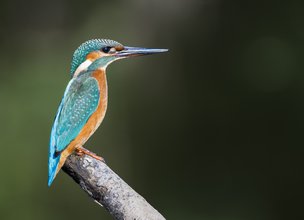Fed by the S. Simão stream, they are an area of high ecological importance.
The Lagoons of Vila Franca are located on the left bank of the Lima River estuary, in Vila Franca, forming part, together with Veiga de S. Simão, of an important wetland of essential conservation. They are fed by the S. Simão stream, about 5 km long, which flows here.
In ecological terms, this wetland is one of the most important in the county, occurring reeds, reeds and paludious forests that require specific and pertinent attention and conservation measures.
They are used by several species of shorebirds and aquatic birds for food and refuge, being especially important at the time of migration or for wintering birds.
In this place, inserted in the Lima River SCZ, the habitats contained in the Habitats Directive occur:
1140 - Mudflats and sands uncovered at low tide
1130 - Estuaries
1330 - Atlantic salty meadows (Galuco-Puccianellietalia maritimae)
1310 - Pioneer vegetation of Salicornia and other annual species in muddy and sandy areas
1320 - Meadows of Spartina (Spartinion maritimae)
1420 - Mediterranean and thermo-Atlantic halophytes (Sarcocornetea fruticosi)
91E0* - Alluvial forests of Alnus glutinosa and Fraxinus excelsior (Alno-Padion, Alnion incanae, Salicion albae) - priority habitat.
The Lagoons of Vila Franca are located on the left bank of the Lima River estuary, in Vila Franca, forming part, together with Veiga de S. Simão, of an important wetland of essential conservation. They are fed by the S. Simão stream, about 5 km long, which flows here.
In ecological terms, this wetland is one of the most important in the county, occurring reeds, reeds and paludious forests that require specific and pertinent attention and conservation measures.
They are used by several species of shorebirds and aquatic birds for food and refuge, being especially important at the time of migration or for wintering birds.
In this place, inserted in the Lima River SCZ, the habitats contained in the Habitats Directive occur:
1140 - Mudflats and sands uncovered at low tide
1130 - Estuaries
1330 - Atlantic salty meadows (Galuco-Puccianellietalia maritimae)
1310 - Pioneer vegetation of Salicornia and other annual species in muddy and sandy areas
1320 - Meadows of Spartina (Spartinion maritimae)
1420 - Mediterranean and thermo-Atlantic halophytes (Sarcocornetea fruticosi)
91E0* - Alluvial forests of Alnus glutinosa and Fraxinus excelsior (Alno-Padion, Alnion incanae, Salicion albae) - priority habitat.
Location
The Lagoons of Vila Franca are located on the left bank of the Lima River estuary, in the parish of Vila Franca.
Coordinates
Lat: 41.693667
Long: -8.757306
Hello little one!
I'm Piquinhos and I can help you learn more about the Geopark!
Biodiversity
Biodiversity
The Lagoons of Vila Franca are extremely important areas for several species of water birds and waders, whether resident, wintering or migratory. One of the most common birds observed in the riverside and in the Lagoons is the guarda-rios (Alcedo atthis) also frequently occurring the (Gallinula chloropus), the garça-real (Ardea cinerea), the garça-branca-pequena (Egretta garzetta) and the mergulhão-pequeno (Tachybaptus ruficollis). The pica-pau-malhado-grande (Dendrocopos major), the pica-pau-verde (Picus viridis), the fuinha-dos-juncos (Cisticola juncidis) and the migratory species águia-pesqueira (Pandion haliaetus) are examples of other species that occur here.
Regarding the flora, there are paludious forests, with characteristic vegetation of riparian gallery. You can see amieiros (Alnus glutinosa), salgueiros (Salix atrocinerea), freixos (Fraxinus angustifolia), carvalhos-comuns (Quercus robur), sanguinhos (Frangula alnus), sabugueiros (Sambucus nigra) e pilriteiros (Crataegus monogyna). In this ecosystem, there are also juncos (Juncus spp.), the junça-marítima (Bolboschoenus maritimus), caniços (Phragmites australis), the tábuas (Typha latifolia), the genciana-das-turfeiras (Gentiana pneumonanthe), the morraça (Spartina marítima), the Sarcocornia perennis, the nenúfar-branco (Nymphaea alba), among other species.
The proliferation of invasive species in this ecosystem has intensified over time, putting the habitats and biodiversity of this place at risk. With regard to flora, canas (Arundo donax), acácia-de-espigas (Acacia longifolia) and erva-das-pampas (Cortaderia selloana) are examples of exotic invaders that are widespread in this place. As for fauna, the most evident invasive alien species is the lagostim-vermelho-do-Louisiana (Procambarus clarkii).
Discover some of the species that can be found in this location, under the "Multimedia" tab.
Child Mode
Discover the geopark in a simpler format, aimed at the little ones.
Clique ENTER para pesquisar ou ESC para sair
